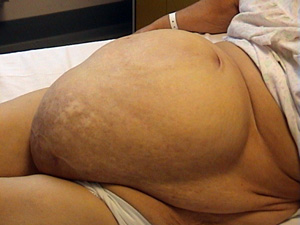

An incisional hernia occurs in an area of weakness caused by an incompletely-healed surgical wound. Since median incisions in the abdomen are frequent for abdominal exploratory surgery, ventral incisional hernias are termed ventral hernias. If it is not caused by an incision, then it is a epigastric hernia. These can be among the most frustrating and difficult hernias to treat.
haematoma: it decrease wound healing
seroma: it decrease wound healing also
infection: also decrease wound healing
poor technique
chronic cough like COPD
constitutions
urinary obstruction, like BPH
pregnancy
ascites
Clinically, incisional hernias present as a bulge or protrusion at or near the area of a surgical incision. Virtually any prior abdominal operation can develop an incisional hernia at the scar area (provided adequate healing does not occur due to infection), from large abdominal procedures (intestinal surgery, vascular surgery), to small incisions (appendix removal, or abdominal exploratory surgery). While these hernias can occur at any incision, they tend to occur more commonly along a straight line from the xiphoid process of the sternum straight down to the pubis, and are more complex in these regions. Hernias in this area have a high rate of recurrence if repaired via a simple suture technique under tension. For this reason, it is especially advised that these be repaired via a tension free repair method using mesh (a type of synthetic material).
Traditional "open" repair of incisional hernias can be quite difficult and complicated operations. The weakened tissue of the abdominal wall is re-incised and a repair is reinforced using a prosthetic mesh. Complications frequently occur because of the large size of the incision required to perform this surgery. These are primarily wound complications such as infection of the incision. Unfortunately, a mesh infection after this type of hernia repair most frequently requires a complete removal of the mesh and ultimately results in surgical failure. In addition, large incisions required for open repair are commonly associated with significant postoperative pain.
Laparoscopic incisional hernia repair is a new method of surgery for this condition.[1][2][3] The operation is performed using surgical telescopes and specialized instruments. The surgical mesh is placed into the abdomen underneath the abdominal muscles through small incisions to the side of the hernia. In this manner, the weakened tissue of the original hernia is never re-incised to perform the repair and one can minimize the potential for wound complications such as infections. In addition, performance of the operation through smaller incisions can make the operation less painful and recovery quicker. Laparoscopic repair has been demonstrated to be safe and a more resilient repair than open incisional hernia repair.
